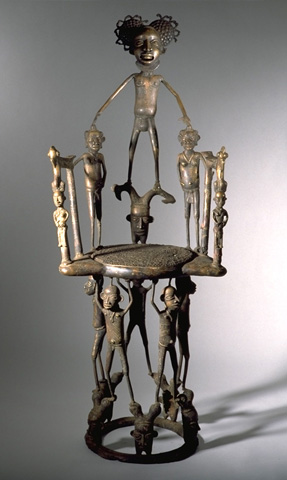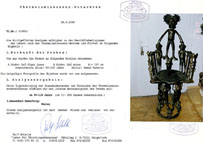Galerie Peter Herrmann |
- | Ancient Art from Africa |
||
 |
Photo: U. Lack |
| Thermoluminescence - Expertise | Throne |
Bamoun. Cameroon One of (probably) twelve thrones from the Sultan of Foumban's palace See one at Lindenmuseum Stuttgart - Germany |
|
| edited in the internet since 1996 |
| Explication |
Translated with www.DeepL.com/Translator (free version) Quite a number of our Bamoun bronzes probably come from the property of King Njoia or from his palace. Research revealed that King Njoia, before the French invasion at the beginning of this century, divided up most of his palace property among various wives. In this way, two large dynasty columns and a vase, this throne, bells, and a number of ivory heraldic and ceremonial horns first came to Bali ( -city ) and from there into the possession of the collection. The throne was included in the gallery inventory in 1988 only with the indication 19th century. If the later ordered TL-expertise is correct, which may be slightly tapered by subsequent heating of the object due to repair of damage, it is the enthronement chair of King Njoia and was cast in the 1880s. Research suggests an original number of thrones totalling twelve. Of these, six are currently traceable. It is now assumed that one such throne was cast for each enthronement of a king. It was flanked on the left and right by two bronze ceremonial staffs, which can also be seen in the Peter Herrmann Gallery. A stool-like caryatid stool that had stood in front of the throne is lost. The patination has matured and the age can easily be guessed by it. A small repair to the left side rest is not visible, the only thing to note here is that this repair may affect the age of the thermoluminescent exhibit as follows: The object warms up when it is re-soldered. This could rejuvenate the values of the radioactive decay time. Thus, the throne could be older than determined by the TL expertise. To the buyer's advantage, the value can only increase should new findings reveal that the throne is even older. Produced in lost casting, i.e. in the lost wax process in several parts and then soldered, this object is considered one of the most beautiful examples of African casting art in the perfection of its manufacture. Five atlases, recognisable as subordinates by their nakedness, filigree worked, which support the seat with hardly believable lightness, form the base. They stand on the heads of slain enemies arranged in a ring, recognisable as notables by their headgear. The seat itself is richly ornamented. The backrest is formed by a group of figures in the middle of which the king himself can be seen, dressed only in a loincloth. He, too, is standing on the head of a slain enemy, who can be identified as the king by the symbolic double cocked hat. Each hand rests on the head of a woman also dressed only in a loincloth. In the hierarchical order, one could assume the queen mother or the first wife here. The armrests are each formed by a dignitary staff, which again bears the symbol of the cock, which in turn rests on the head of a seated female figure. Foumban is now one of the southernmost fringes of Islam. Shortly after the time of the establishment of the throne, King Njoia concluded a treaty with the Fulbe and peacefully began the Islamisation of his subjects. Interestingly, the same motifs are still being cast to this day - despite Islam's ban on figurative depictions. |
